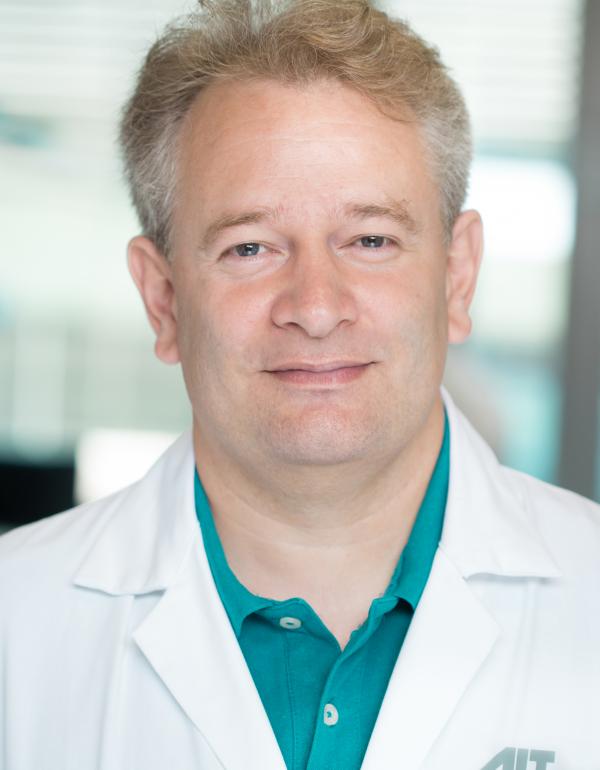
Winfried Neuhaus is one out of six Principal Scientists at the AIT and heading the group Biological Barriers. He studied food- and biotechnology at the University of Natural Resources and Life Sciences in Vienna (Austria) and received his PhD from the University of Vienna (Pharmaceutical Sciences). Before he joined the AIT, he worked at the University Hospital Wurzburg (Germany) as PI for six years and was granted his habilitation in Molecular Medicine. In addition, he was employed at the Medical University Vienna (Institute of Medical Genetics, 2015-2016) and the University of Vienna (Department of Pharmaceutical Chemistry, 2013-2016). Before he started in Wurzburg in 2010, he was leader of the “Preclinical and Blood-Brain Barrier Research Group” in the pharmaceutical industry company PharmaCon GmbH for two years. In total, Winfried Neuhaus has over 20 years expertise in the biological barriers research field especially for in vitro models and in vitro/in vivo translatability in health and disease. He has supervised over 25 master theses and 10 doctoral theses. He is author of >80 publications in peer-reviewed journals, most of them with first or corresponding authorships, five book chapters, one book and > 100 abstracts. He is engaged as reviewer for several scientific journals and funding agencies, member of several advisory boards, member of the EPAA mirror group, the current president of the European Society for Alternatives to Animal Testing (EUSAAT), coordinator of the 3Rs centre network EU3Rnet, Professor for 3Rs and New Approach Methodologies at DPU Krems, Austria and is teaching at five universities.
Towards the development and applications of blood-brain barrier in vitro models for neurotoxicity assessment
Authors: Anna Kruselj-Fraincic, Katrin Panke, Claudia Pitzl, Aleksandra Chmielewska, Sylvia Bekhit, Alena Bogomolova, Anna Spilak, Adrian Klepe, Duygu Sorhun, Andreas Brachner, Winfried Neuhaus
Affiliations:
AIT - Austrian Institute of Technology GmbH, Competence Unit Molecular Diagnostics, Giefinggasse 4, 1210 Vienna, Austria
To perform risk assessment of chemicals, drugs and particles, the regulatory OECD guidelines to determine neurotoxicity are based on animal testing. In addition to ethical concerns, inherent problems such as lack of translatability between animals and humans encouraged the development of new approach methodologies (NAMs) such as in silico and in vitro models. The development and validation of robust NAMs fit for regulatory needs are in line and support the current European policy of phasing out animal testing for which the European Commission will publish the roadmap in Q1/2026. The OECD has identified the role of the blood-brain barrier as a gap in the developmental neurotoxicity (DNT) test batteries currently being developed. As part of the European Partnership Programme PARC with over 200 participating research institutions, we developed different set-ups for adult neurotoxicity (ANT) and DNT testing based either on human iPSC-derived brain capillary endothelial-like cells (BCECs) or the immortalized cell line hCMEC/D3. The development of the BBB in vitro models, their applications and findings will be presented.
A set of selected neurotoxins, a mixture of PFAS and various nanoplastics were tested and showcased the broad applicability of the models obtaining data in one test set-up about permeability, changes of the barrier properties, the communication of the BBB with various CNS cells and effects on CNS cells on functional and molecular levels (e.g. RNAseq, DNA- methylation). One out of several interesting findings was the relevance of medium pH indicator phenolred for the successful BCECs differentiation revealed during studies about endocrine disruptors.
Acknowledgement: This work was carried out in the framework of the European Partnership for the Assessment of Risks from Chemical (PARC) and has received funding from the European Union’s Horizon Europe Research and Innovation Programme under Grant Agreement No 101057014, the project CHIASMA has received funding from the European Union’s Horizon Europe Research and Innovation Programme: Grant Agreement No. 101137613, the project InChildHealth has received funding from the European Union’s Horizon Europe Research and Innovation Programme: Grant Agreement No. 101056883. Views and opinions expressed are however those of the author(s) only and do not necessarily reflect those of the European Health and Digital Executive Agency (HaDEA). Neither the European Union nor the granting authority can be held responsible for them. We further gratefully acknowledge the financial support provided by the Austrian Science Fund FWF (project P 34137-B).
